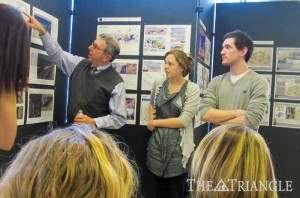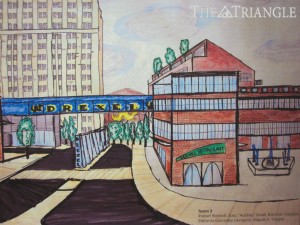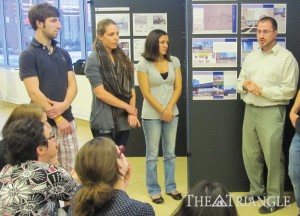The Department of Architecture and Interiors hosted its fourth annual design charrette April 1-4 in collaboration with Goody Clancy, the architectural firm working on Drexel’s campus master plan.
In previous years, the charrette — a design challenge completed by teams of students over the course of a weekend — has focused on off-campus scenarios including transit, public spaces and humanitarian design. This year the organizers turned their attention homeward, taking a critical look at the past, present and future of Drexel’s campus.
According to Nicole Koltick, assistant teaching professor in the Department of Architecture and Interiors and co-chair of the 2011 charrette, “our department head, John Coddington, brought the idea to us … he thought it would be a really great experience for the students to actually have a voice in the planning process, and once we broached the idea with Goody Clancy, the planners, they were very excited about it.”

Also speaking on the panel were George Poulin, president of the Powelton Village Civic Association; Jose Almanana, a landscape architect with Andropogon and Powelton Village resident; Amy Rees, an environmental graphic design instructor; and David Dixon, principal at Goody Clancy.
“There has never been a more important time to think about the future of American universities,” Dixon said. He called Philadelphia a “post-modern city,” and cited statistics indicating that younger generations have a greater interest in living in walkable, urban neighborhoods rather than the suburbia preferred their parents.
During his presentation, Dixon asked the crowd how many had heard of the Princeton Review’s ranking of Drexel’s campus as one of the ugliest, and the majority of the audience raised their hands.
After working with students during the charrette, he told The Triangle, “I heard a lot of people say, well we have an ugly campus, but then they would say how much they like being at Drexel. And those two [statements] … suggest not so much a disconnect, but the fact that we all need to appreciate that we’re designing not for the past, but for the present and the future. What is considered good is changing.”
Alluding to Coddington’s panel presentation, he explained, “We still tend to admire the campuses of old — Penn is an example — that were built to mimic an aristocratic British model … there is a certain image or stereotype that people have of what a good campus is — it has a lot of green quads and gothic buildings and things like that. At the same time, students are very different today — they are much more diverse, they come from many more backgrounds … and in many ways Drexel is much more set up — because it’s right in the midst of the city — to offer a kind of vibrant, vital urban experience that matters more to kids today.”
Throughout the weekend, around 50 students of varying majors worked around the clock, drawing on the themes established by the panel and their own experiences as Drexel and Philadelphia residents. They presented their concepts for a 21st-century campus to critique panels April 4 in the lobby of the Recreation Center.

Many teams had futuristic ideas that may inspire the master plan. Team 7 thought up solar charging centers, wind turbines and urban farming facilities.
Xiaonan Xu, a second year environmental engineering student on Team 7, said she enjoys working with architects and designers because they aren’t as concerned as engineers about making things practical.
“It doesn’t necessarily have to be effective right now … we’re planning 20 years away,” Xu said. “We can make it work better later on.”
Howard Jeffers III was also on Team 7; a sixth year architecture student, he is the only one to participate in all four years of the Drexel design charrette.
Jeffers said though the campus-themed charrette seemed simpler at first than past years, it was in some ways more complicated because of how many ideas students have for their surroundings.
“You just wonder how do you tackle something, how do you weave that common thread to make something happen?” he said of their challenges.
Ashley Mastony, interior architecture second year graduate student on Team 7, said, “It’s easy for the scope to get way too broad and you’ll never finish … we would have to be like, ‘Alright, does this suit our goals?’ and bring it back to that.”
The students sacrificed sleep and getting assignments in on time to churn out their concepts in time for the final presentations.

“I think it’s amazing,” Koltick said, “that students are willing to devote this much time outside of their studies to an event like this … and I think the quality of the work is really amazing for two days of work.”
Dixon said he has worked with other universities before and was very impressed by Drexel students: “They are really interested in the city around them … in how they can all learn from each other, in what’s happening in larger terms … and interested in how to use what they’re learning to really have an impact on the world around them.”
Dixon and his colleague Ben Carlson worked with the students on Saturday, and watching students work out ideas gave the planners a lot of insight into what is needed on campus.
“We got a real appreciation, a better appreciation, for how busy they are, and therefore how much the campus needs to be convenient for them,” Dixon said. “Students do a lot of very different things during the day … you need a campus that is really like a city … it has the things people need where the need it, when they need it. Formal organization into single-use areas — academics here, housing there, student life someplace else, recreation someplace else — does not suit the learning styles or lifestyles of Drexel students.”
Dixon and Carlson had to leave campus before the final presentations, and they will have a lot to digest and consider for the master plan.
“I’m not sure if they’ll accept the forms as they are,” Jeffers said, “but I think our bigger ideas will be accepted.” He said the planners responded very well to the ideas the students came up with on Saturday.

